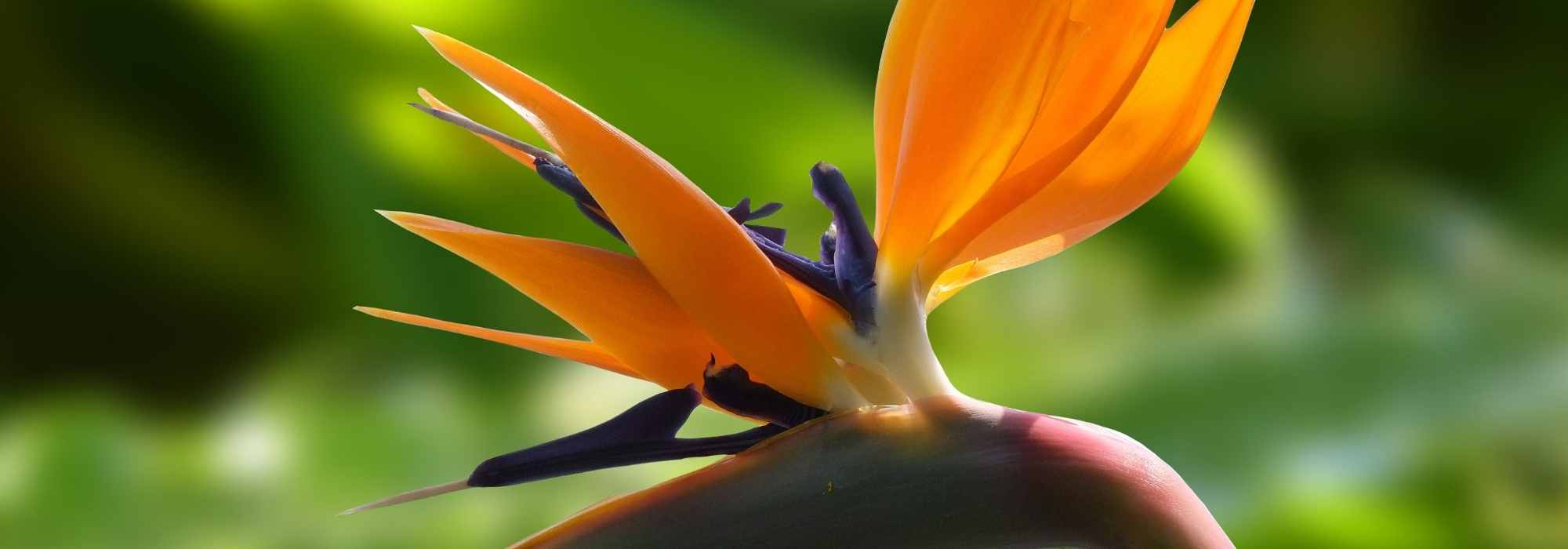
Strelitzia, Bird of paradise: planting and care
Contents
Strelitzia in a nutshell
- Strelitzia is a tender perennial with a strongly exotic appearance, which can be grown in large pots to be stored indoors during winter, but also in open ground in our mildest regions.
- In summer, it produces large flowers resembling tropical bird heads.
- It forms large clumps of upright, very impressive and lush leaves.
- It is only sensitive to frost and thrives in any fertile soil in a well-sheltered spot.
- A centrepiece in an exotic-themed border in mild climates!
A word from our expert
Strelitzia, commonly known as the “Bird of Paradise,” is a stunning perennial plant with a wildly exotic appearance! Its lush foliage and vibrantly coloured flowers shaped like a bird’s beak, topped with ruffled bright orange and blue petals in Strelitzia reginae, the favourite among florists, and white and blue in the Strelitzia nicolai, always make a striking impression! Also discover the superb flowering of the species Strelitzia juncea and the lovely varieties like ‘Mandela’s Gold’ or ‘Humilis’.
Unfortunately, its flamboyant colours are matched only by its poor cold resistance! Very frost-sensitive, the strelitzia will only thrive in open ground in the warmest regions of our country; elsewhere, when grown in a pot, it will bring a “jungle” touch to your interior. You can take it outside during the warmer days on the terrace or balcony so it can enjoy the heat.
Easy to grow, it only fears frost and thrives in any fertile soil in a well-sheltered spot.
Adopt this little exotic bird in your garden or in a pot: a guaranteed change of scenery!
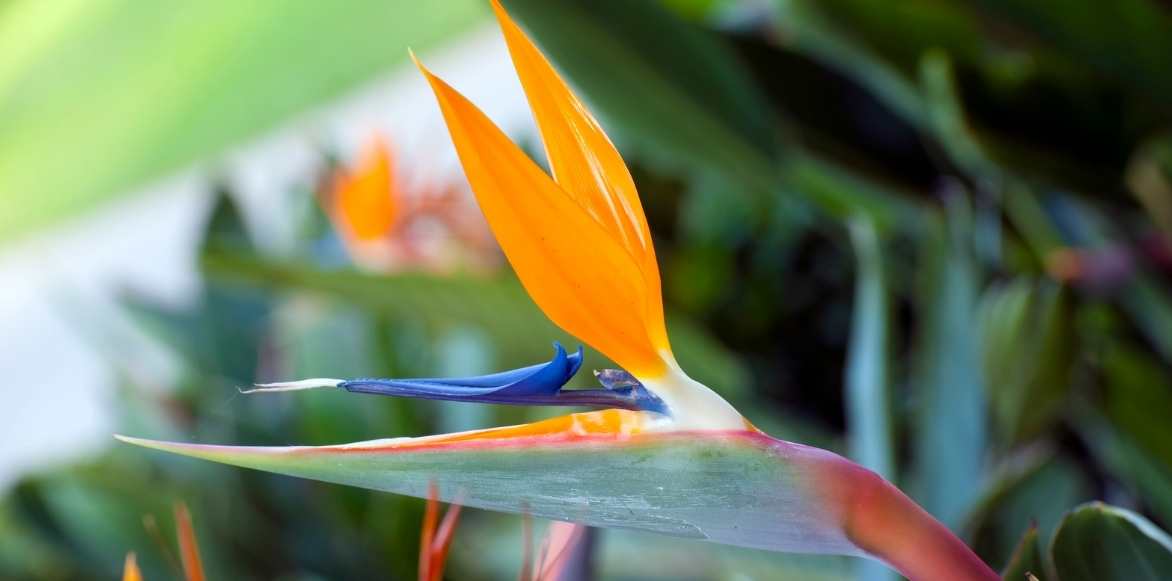
Description and botany
Botanical data
- Latin name Strelitzia
- Family Strelitziaceae
- Common name bird of paradise
- Flowering June to October
- Height 0.60 to 2 m
- Exposure sun
- Soil type rich and light
- Hardiness frost-sensitive
Strelitzia, commonly known as “Bird of Paradise”, is a perennial plant belonging to the family Strelitziaceae. The genus comprises only 5 species of Strelitzia that grow naturally in the clearings and along the banks of South African rivers. Strelitzia reginae is the most cultivated, commonly found at florists. This species comes in several cultivars, including ‘Humilis’, a dwarf variety that does not exceed 80 cm in height. Strelitzia alba features large white inflorescences. There is also Strelitzia juncea, the hardiest species (-3°C), and Strelitzia nicolai, with white and purple flowers, rarer in cultivation, which grows in clumps up to nearly 10 m tall.
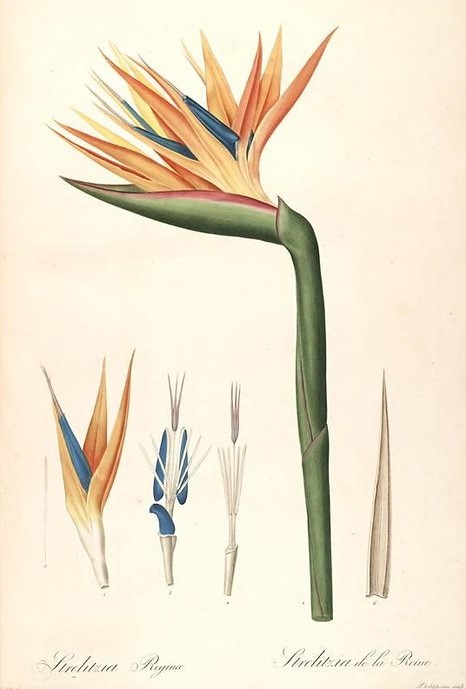
Strelitzia botanical plate (circa 1810)
From its South African origins, the plant retains a significant frost sensitivity; it will be cultivated in the ground only in the mildest areas of our country. Indeed, it is often planted to flower public beds in temperate and mild regions or in tropical gardens. In areas where temperatures drop below 10 °C, it can be admired in a large pot placed on the terrace or balcony throughout the beautiful season. It must be brought indoors in winter.
The Strelitzia forms a clump of impressive evergreen leaves resembling a small palm. The smaller varieties do not exceed 80 cm in height, while the larger ones generally reach 1.50 to 1.80 m. In the wild, some Strelitzia can reach 10 m in height. It is a rhizomatous perennial that spreads laterally through its succulent roots, producing offsets over more than 1 m. Strelitzia nicolai develops several false trunks.
The decorative and evergreen foliage of the Strelitzia expresses all the exotic charm! It is particularly ample and opulent. The straight, robust, and unbranched stems bear large lanceolate, oblong, long-petiolate, leathery leaves that fan out. Supported by long petioles measuring 100 cm to 120 cm in length, they are about 15 cm wide and 30 to 60 cm long. They give a lush appearance to the plant and resemble those of banana plants. The leaves are simple, entire, arranged alternately, and imbricate with one another. They are sheathing at the base. Strelitzia juncea, sometimes called “bird of paradise with rush stems”, is distinguished from its relatives by its long cylindrical stems resembling needles and almost devoid of leaves, evoking a large rush.
They display a deep green, pruinose hue with grey-blue reflections. Their lamina features beautiful striations and is marked by a prominent midrib, sometimes tinged with purple.
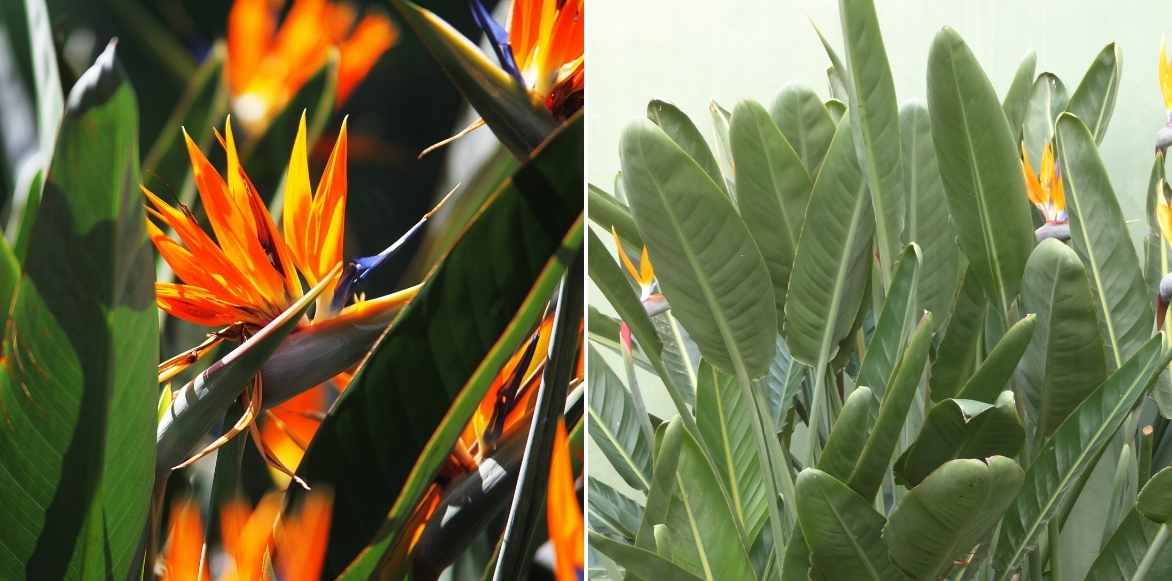
Flowers of Strelitzia reginae and foliage (© Gwenaëlle David)
In our climates, flowering occurs in summer, from June to September. It is remarkable! The large upright flowers, resembling exotic birds, are of rare beauty. Towering, they emerge from long floral spikes reaching over 1 m in height. Do not be surprised if you feel your Strelitzia is being temperamental: like a diva, it makes you wait; it takes about 6 months from the appearance of the flower buds to their blooming. Indoors, it can bloom in winter, from December to May.
From green spathes or bracts edged in red or purple, pointed and rigid, measuring 10 to 20 cm long, inflorescences emerge, each housing a crest of flowers. Each flower consists of 3 petals, one smaller, and 2 long, thin tongues, all mimicking the head of a tropical bird with ruffled crests, reminiscent of the plumage of birds of paradise. They are bright orange and blue in Strelitzia reginae, white and bright blue in Strelitzia nicolai, and yellow and blue in Strelitzia reginae ‘Mandela’s Gold’.
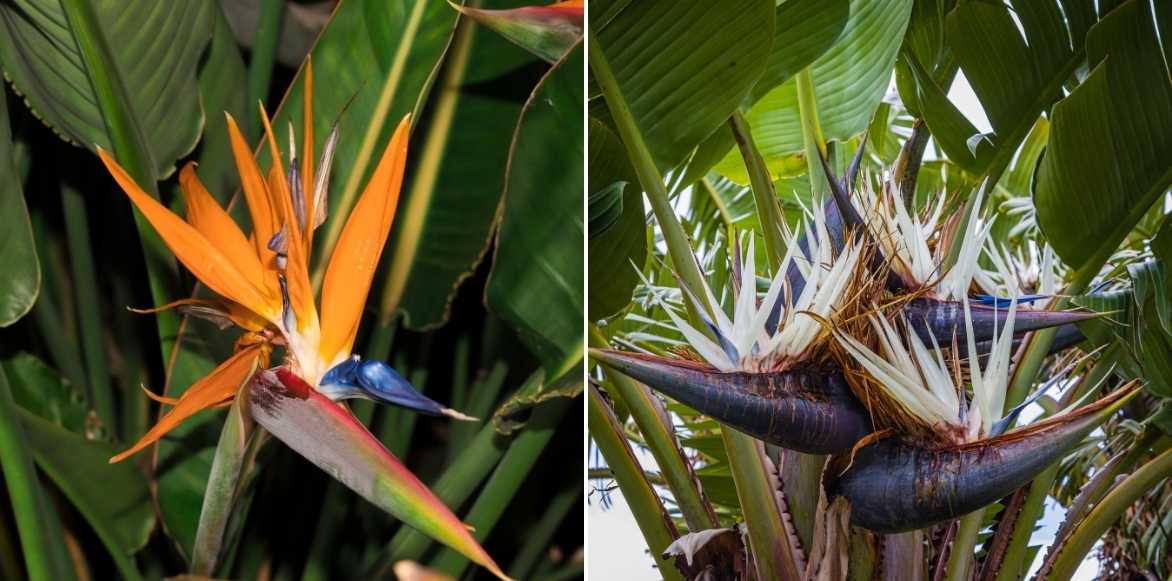
Strelitzia reginae and Strelitzia nicolai
Due to its extraordinary structure, vibrant and complementary colours, and long vase life, Strelitzia reginae is considered “The” cut exotic flower par excellence.
Flowering is followed by the formation of capsules containing seeds with a cottony covering, often slightly reddish. You can collect them for sowing.
“`
Read also
To grow Strelitzia in a potMain species and varieties
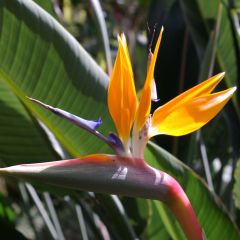
Strelitzia reginae
- Flowering time July to October
- Height at maturity 1,50 m
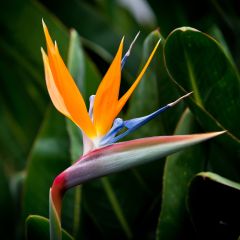
Strelitzia reginae Humilis
- Flowering time July to October
- Height at maturity 90 cm
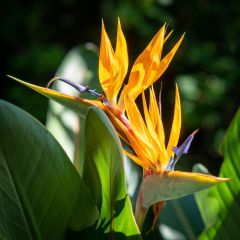
Yellow bird of paradise Seeds - Strelitzia reginae Mandela’s Gold
- Flowering time July to October
- Height at maturity 1,80 m
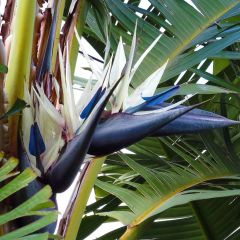
Strelitzia nicolai
- Flowering time July to October
- Height at maturity 2,50 m
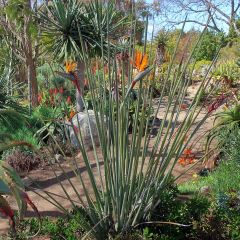
Strelitzia juncea
- Flowering time July to October
- Height at maturity 1,50 m
Discover other Strelitzia - Bird of Paradise
View all →Available in 1 sizes
Available in 2 sizes
Available in 2 sizes
Available in 1 sizes
Available in 1 sizes
Available in 1 sizes
Available in 1 sizes
Planting Strelitzia
Where to plant?
The Strelitzia requires warmth and light. It is a subtropical plant suited to warm climates that does not tolerate frost. It cannot withstand temperatures below 10°C, which is why, in most of our regions, it is usually grown in pots to be brought indoors, protected from frost during winter. It can only be grown in the ground in the mildest areas of our country, although it can tolerate a few light and short frosts (-3 to -5°C) in very well-drained soil. It is also a beautiful conservatory plant to cultivate in a very bright and minimally heated location. It should especially be kept away from temperatures below 12°C. Its extraordinary flowering makes it an ideal choice for creating large, lush pots that can be kept throughout the summer or in the conservatory during winter.
If your climate allows, plant your bird of paradise in the ground in full sun, preferably in a sheltered spot from cold and prevailing winds, against a south-facing wall. In the southern parts of our country, it will accept partial shade. It is easy to grow in fertile soil, rich in organic matter, kept moist throughout the growing season but especially very porous and extremely well-drained.
In the garden, it can be used in a colourful summer exotic bed or as a solitary feature in the middle of a lawn to enhance its visibility.
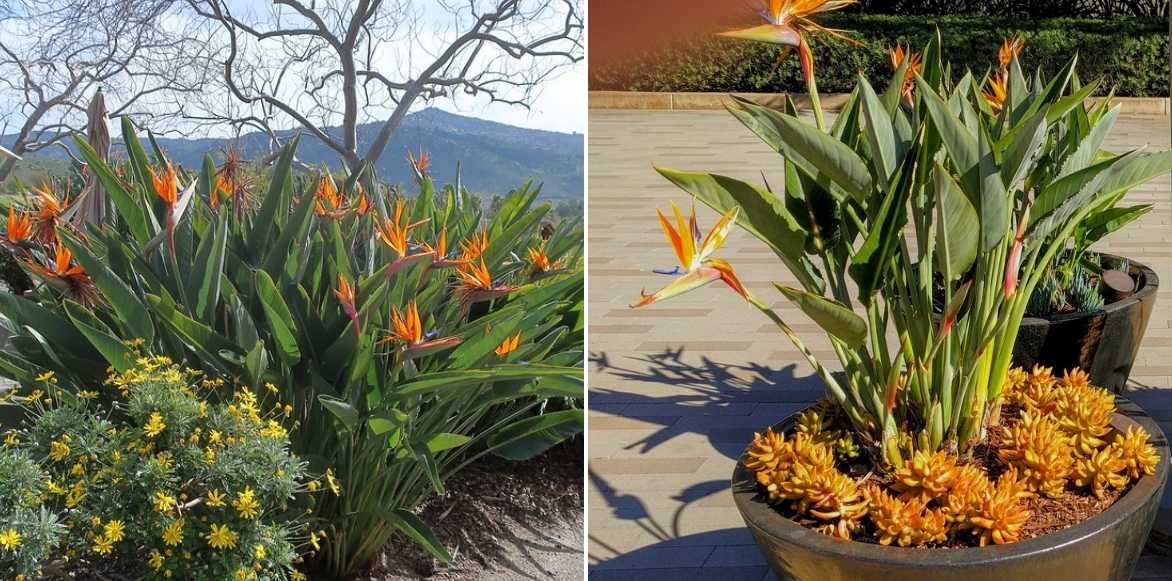
Strelitzias in a bed alongside Euryops pectinatus and in pots (© KM)
When to plant the bird of paradise?
Plant the Strelitzia pots in the ground only when the risk of frost has passed, during May or June. You can plant as early as March-April if you live in a region with a mild climate. For indoor pot cultivation, you can plant all year round.
How to plant it?
In the ground
Maintain a distance of 50-60 cm between plants, installing about 2 plants per m². We suggest adding well-decomposed manure or compost, as Strelitzia prefers soils rich in organic matter.
- Dig a hole three times wider than the root ball
- Make a good gravel bed to ensure proper drainage
- Place the root ball in the centre of the hole and plant in a mixture of potting soil and compost mixed with sand, without burying the collar
- Backfill the hole and firm down with your foot
- Water generously
In a pot
- Choose a pot with a diameter of at least 30 cm with drainage holes
- Spread a layer of gravel or clay balls 2 to 5 cm thick at the bottom of the pot
- Plant in a mixture of 1/3 potting soil, 1/3 river sand, and 1/3 garden soil without burying the plant’s collar
- You can also add a bit of compost
- Firm down and water
- You can place it in the garden from the end of May
While waiting for the warm days, you can place the pot in a greenhouse, conservatory, or a very bright and minimally heated room in the house.
⇒ For more information: Growing Strelitzia in a pot
Read also
How to design a tropical garden?Sow the seeds of bird of paradise
Sowing can be done from January to December.
- Soak the seeds in hot water for 36 hours before sowing and carefully remove the orange fluff from the side of the seed.
- Sow the seeds in pots (or in a heated propagator) filled with good seed compost: sow 1 seed per pot.
- Cover the seeds with 1 cm of compost.
- Lightly firm down.
- Water thoroughly with a fine spray and keep moist throughout the germination period, which takes 1 to 6 months.
- Place your pots in the dark at a temperature of 21°C to 24°C.
- Repot when the young plants are large enough.
- Transplant to the garden when all risk of frost has passed.
Care
In the ground
The bird of paradise is easy to grow as long as it has enough food, water, and light. For the first two years after planting, watering should be regular and generous in summer, but avoid excess moisture. In winter, water occasionally.
Once well established, it will tolerate drought better.
Apply fertiliser or organic matter (compost, dried blood, or roasted horn) at least twice a year, in spring and autumn.
If you live in a warm climate, you can leave the plant in place, but protect it from cold snaps with a thick mulch. In winter, wrap it with a frost cloth.
In spring, simply tidy the clump by removing yellow, spotted, or dry leaves and spent stems.
In a pot
Water regularly twice a week in summer with rainwater if possible, during the growth period, but allow the substrate to dry out by 3 cm between waterings. Never let water stagnate in the saucer. Be cautious of sunlight through windows that could scorch the foliage; prefer filtered light. If your climate allows, take your plant outside from June to September.
In winter, place the plant in a bright, cool room where the temperature will not drop below or exceed around 13°C. Water once every 15 days in winter. From February to the end of August, water the base with liquid fertiliser twice a month. Stop fertilising in winter.
Top up with potting soil and compost once a year in spring.
The bird of paradise does not really suffer from diseases or pests. When grown indoors, it may occasionally be attacked by mealybugs that settle on the old foliage. Cut off the affected leaves and remove the mealybugs with a cotton pad soaked in 90% alcohol. Then spray with rapeseed oil, repeating two or three times at 15-day intervals.
Always allow the substrate to dry out between waterings to prevent collar rot.
→ Learn more in Growing a Bird of Paradise indoors and My Strelitzia isn’t flowering: causes and solutions.
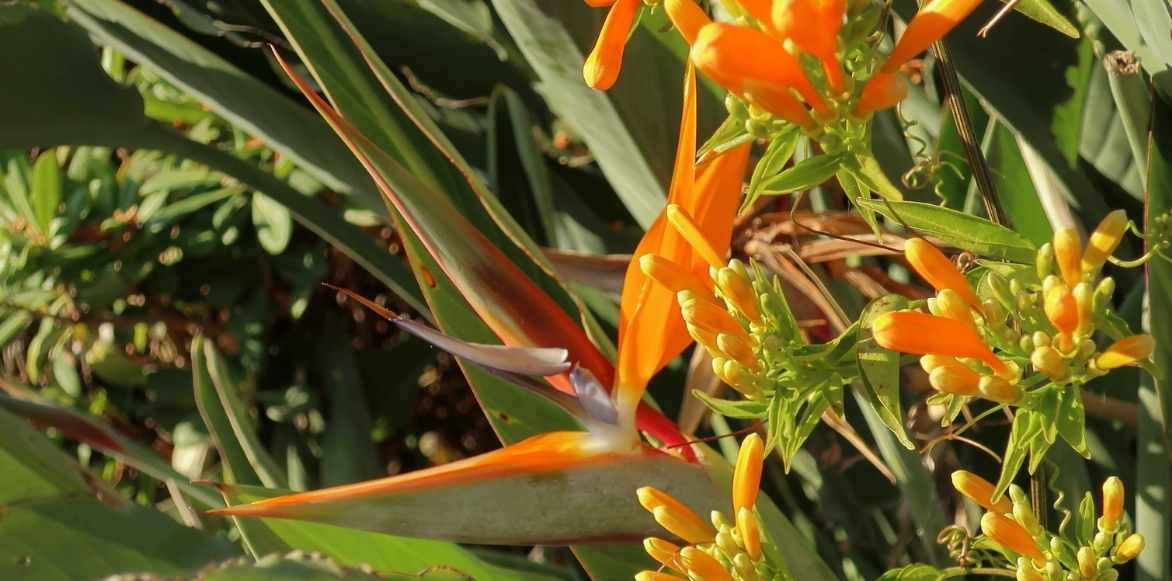
Strelitzia reginae and Pyrostegia venusta (© KM)
Multiplication
Strelitzia is multiplied by division of the stumps in spring, a method that ensures you obtain exactly the same variety. It is also possible to sow strelitzia seeds, but be aware that it often takes 3 to 10 years of cultivation to enjoy the flowers! Plants from division are likely to flower within the year.
Dividing strelitzia clumps
This is done after 3 or 4 years, when the plant is well established.
- Using a sharp spade, gently lift the clump to avoid damaging the rootstock
- Cut off a few clumps from the periphery with shoots that have roots
- Separate the shoots using a sharp knife
- Fill a few pots with potting soil mixed with a little sand
- Plant the pieces of rootstock 10 cm deep
- Firmly compact the soil
- Water moderately and then regularly
- Place the pots in a sheltered location, in a relatively warm spot (20 °C). This allows the shoots to start their growth under optimal conditions
After 4 weeks, you can plant them directly in the garden in well-prepared soil when there is no longer a risk of frost, or in pots.
Sowing
See our section dedicated a little higher up, “Sowing Bird of Paradise seeds”.
Pairing ideas
Strelitzia is perfect for creating a vibrant exotic border in well-sheltered gardens, protected from frost. It allows for the creation of stunning exotic displays in the middle or back of a border, or even in large pots on the terrace. With its opulent clumps, it adds volume and height to a border; place it among slightly shorter perennials like brightly coloured begonias (Begonia semperflorens ‘F1 Big Red Bronze Leaf’).
It will bring a very exotic touch to the garden alongside a Melianthus major.
Complement the vibrant colours of its flowers with other flamboyant blooms, such as those of cannas, crocosmias, kniphofias, or hedychiums like ‘Tara’.
Incorporate it into a lush summer border, alongside Rudbeckia, orange-flowered dahlias, gladioli, daylilies, or a Billbergia nutans.
Create a lush display by pairing it with other plants that have broad foliage, such as banana plants, colocasias, castor beans (Ricin communis ‘Honolulu‘), and possibly a small palm, such as Sabal minor for example.

An orange and blue combination of Strelitzias, Agapanthes, and Daylilies ‘Fulva’
Useful resources
Our article: The best flowers and foliage for long-lasting cut flower arrangements
- Subscribe!
- Contents
































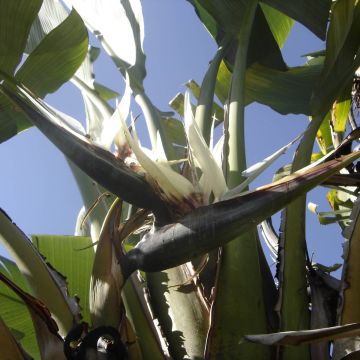

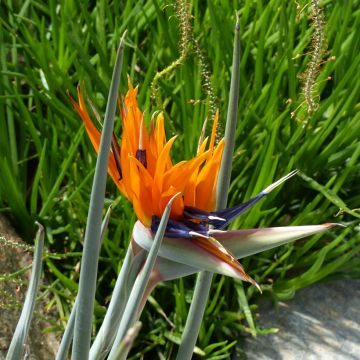



Comments